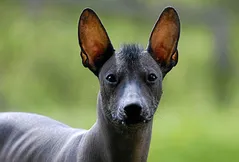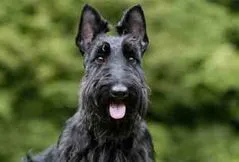
German Longhaired Pointer
The German Longhaired Pointer has a full tail and a long coat with dense guard hairs and a moderate undercoat.
Overall Status
| Height | 22 to 28 inches |
| Temperament | Versatile, Calm, Family-Oriented |
| Weight | 55 to 80 pounds |
| Life Expectancy | 12 to 14 years |
| Coat Color | Brown, Roan, Dark, Chocolate, White & Choc |
| Barking Level | When Necessery |
Quick Factors
| Playfulness | |
| Dog Friendly | |
| Exercise Need | |
| Grooming Needs | |
| Strangers Friendly | |
| Family Affectionate |
Daily Care
Grooming Tips
The German Wirehair has a harsh double coat that is easy to care for in some respects but does have some special needs. For one, it must be stripped — dead hair plucked out by hand or with a stripping knife —which can be tedious. Most GWPs must be stripped twice a year, in the spring and fall. Tools you’ll need to groom this breed are a bristle brush, a stainless steel comb, and an assortment of stripping knives. Ask your dog’s breeder for advice on how to strip the coat or visitthis GWP breeder’s blogfor excellent tips on grooming the GWP.If his coat is properly cared for, a GWP rarely needs a bath unless he has rolled in something stinky. Let the mud dry and then brush it out. Look for a shampoo formulated for dogs with wirehaired coats.Be sure to check the paw pads regularly for anything that might be stuck in the furor between the toes such as seeds, stickers, or sticky substances such as tar. Comb out the beard and mustache daily to remove food or anything else stuck in it.Check the ears on a weekly basis for signs of infection, irritation, or wax build up. Cleanse regularly with a veterinarian-approved cleanser and cotton ball. Brush the teeth at least once per week to prevent tartar buildup and fight gum disease. Additionally, nails should be trimmed once per month if the dog does not wear down the toenails naturally.
Exercise Tips
GLPs are, indeed, high energy with good breeding and have tremendous hunting drive and desire. They need a considerable amount of exercise and attention and need to be in the households of avid bird hunters. They are not suitable for occasional hunters. Besides hunting, other options for exercise could includeplaytime in the backyard, preferably fenced, or taken for walks several times a day.Other outdoor activities like swimming and hiking can provide a good outlet for expending energy.Training for dog sports like agility, obedience and rally can also be a great way to give your dog exercise.With this said, Toller puppies should not be given too much exercise because their joints and bones are still growing and too much pressure on them could result in causing a dog a few problems later on in their lives. They should not be allowed to jump up or off furniture nor should they be allowed to run up and down the stairs because this puts too much pressure on their still growing joints and limbs.
Feeding Tips
As a breed that weighs over 50 pounds at maturity, the German Longhaired Pointer should be fed a high-quality dog food formulated for large breeds. These recipes are made with plenty of protein to support your dog’s lean muscle mass with moderate fat content to prevent obesity. If you use your dog for hunting, however, you may want to consider an active or working breed formula to account for his high energy requirements.If you get a Samoyed puppy from a breeder, they would give you a feeding schedule and it's important to stick to the same routine, feeding the same puppy food to avoid any tummy upsets. You can change a puppy's diet, but this needs to be done very gradually always making sure they don't develop any digestive upsets and if they do, it's best to put them back on their original diet and to discuss things with the vet before attempting to change it again.Older dogs are not known to be fussy or finicky eaters, but this does not mean you can feed them a lower quality diet. It's best to feed a mature dog twice a day, once in the morning and then again in the evening, making sure it's good quality food that meets all their nutritional requirements. It's also important that dogs be given the right amount of exercise so they burn off any excess calories or they might gain too much weight which can lead to all sorts of health issues. Obesity can shorten a dog's life by several years so it's important to keep an eye on their waistline from the word go.Learn about which human foods are safe for dogs, and which are not. Check with your vet if you have any concerns about your dog’s weight or diet. Clean, fresh water should be available at all times. Like many large breeds, Saint Bernard can experience bloat, a life-threatening condition where the stomach distends and twists. The causes of bloat aren’t fully understood, but experts agree that multiple, small meals per day and preventing vigorous exercise around mealtimes may help reduce the chances of it happening.
Health Tips
All dogs have the potential to develop genetic health problems, just as all people have the potential to inherit a particular disease. Run, don’t walk, from any breeder who does not offer a health guarantee on puppies, who tells you that the breed is 100 percent healthy and has no known problems, or who tells you that her puppies are isolated from the main part of the household for health reasons. A reputable breeder will be honest and open about health problems in the breed and the incidence with which they occur in her lines.The average life expectancy for the GSP is between 12 and 14 years. Breed health concerns may includebloat, central diabetes insipidus, cleft palate,cranial cruciate ligament rupture (CCL or ACL), epilepsy,eye problems, hereditary lupoid dermatosis, oropharyngeal neoplasia and nasal cavity tumors,von Willebrand diseaseand XX sex reversal.
Trainability
The modern German Longhaired Pointer is an intelligent and hard working breed. Developed as a multipurpose gundog, the GLP has the potential to learn a great many skills. These dogs are steady in temperament and they love to work, so they are generally fairly easy to train. They do, however, require a firm and consistent hand in training to prevent any stubborn tendencies that may still be lingering. These dogs respond well to positive reinforcement training.Puppies should be properly socialized to develop the amiable, outgoing personality that is characteristic of the breed. They’re successful in performance and companion events such as earthdog, barn hunt, obedience, and agility.
History
British sportsmen bred specialized hunting dogs for various types of birds and different kinds of terrain, to work on either land or lake, and with disparate hunting techniques—hence the profusion of British setters, spaniels, and retrievers. The hunters of Continental Europe took a different approach: They created bird dogs capable of doing it all. Italy’s Spinone, Hungary’s Vizsla, and Germany’s GWP are examples of these famously versatile hunting companions, sometimes called the “European utility breeds.”The name German Wirehaired Pointer is the English translation of the German breed name, Deutsch-Drahthaar. The breeding of wire-coated pointing dogs was something of a mania among German sportsmen of the early 1800s. During the second half of the century, dog people in Britain and on the Continent became passionate about classifying dogs by breed rather than merely type. Thus, such harsh-coated gundogs as the GWP, Pudelpointer, and German Broken-coated Pointer, among others, were officially established as separate breeds.The Wirehair was accorded breed status in Germany in 1870, but it took longer for him to achieve recognition in the United States. The first German Wirehairs were imported in 1920, and the American Kennel Club recognized the breed in 1959. They rank 73rdamong the dogs registered by the AKC, a testament to their popularity as hunting and field trial dogs.






